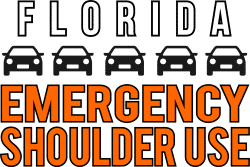The FDOT office of emergency management has released a new video to help educate the public on ESU.
Emergency Shoulder Use (ESU) is Florida’s innovative strategy to increase traffic capacity during major hurricane evacuations using existing paved shoulders. First developed in 2017 and covering key corridors within the state, ESU plans replace the former one-way plans, also known as contraflow and lane reversal.
ESU plans cover the following roadway segments.
Interstate 4
- Eastbound from US 41 in Tampa (Hillsborough County) to SR 417 in Celebration (Osceola County)
Interstate 10
- Westbound from SR 23 in Jacksonville (Duval County) to Interstate 75 in Lake City (Columbia County)
- Westbound from Interstate 75 in Lake City (Columbia County) to US 319 in Tallahassee (Leon County)
Interstate 75
- Northbound from SR 951 in Naples (Collier County) to SR 143 in Jennings (Hamilton County)
Interstate 75 Alligator Alley
- Northbound from US 27 in Weston (Broward County) to SR 951 in Naples (Collier County)
- Southbound from SR 951 in Naples (Collier County) to US 27 in Weston (Broward County)
Interstate 95
- Northbound from SR 706 in Jupiter (Palm Beach County) to south of Interstate 295 in Jacksonville (Duval County)
Florida’s Turnpike
- Northbound from SR 50 in Winter Garden (Orange County) to US 301 in Wildwood (Sumter County)
You can learn more about ESU and how it works by watching our brief public information video.
ESU was first implemented during Hurricane Irma in September 2017. Evacuees were able to drive on the inside shoulder of I-75 northbound from Wildwood to Georgia and on I-4 northbound from Tampa to Kissimmee.
Real-time traffic information is always available by visiting fl511.com or calling 511.

